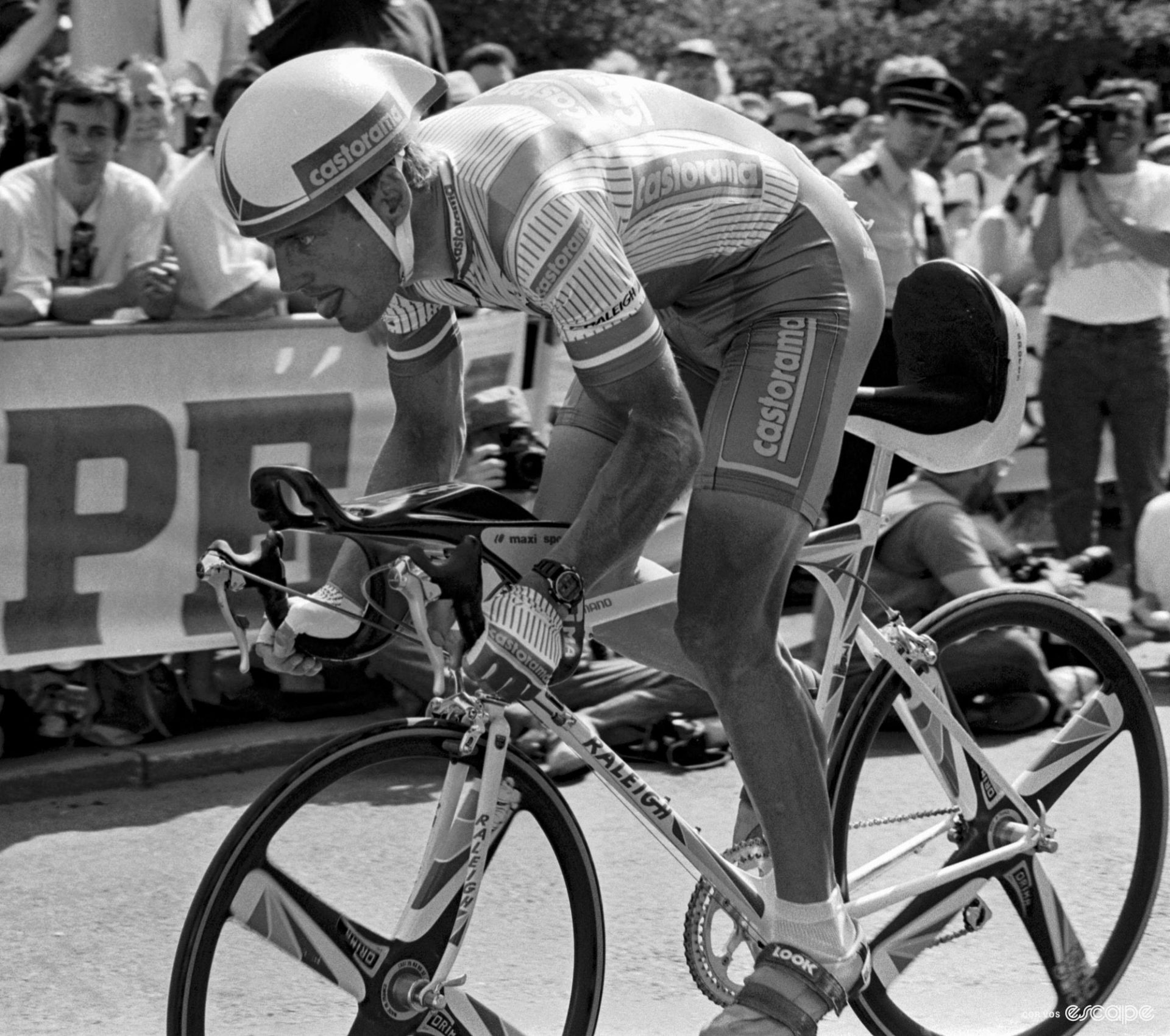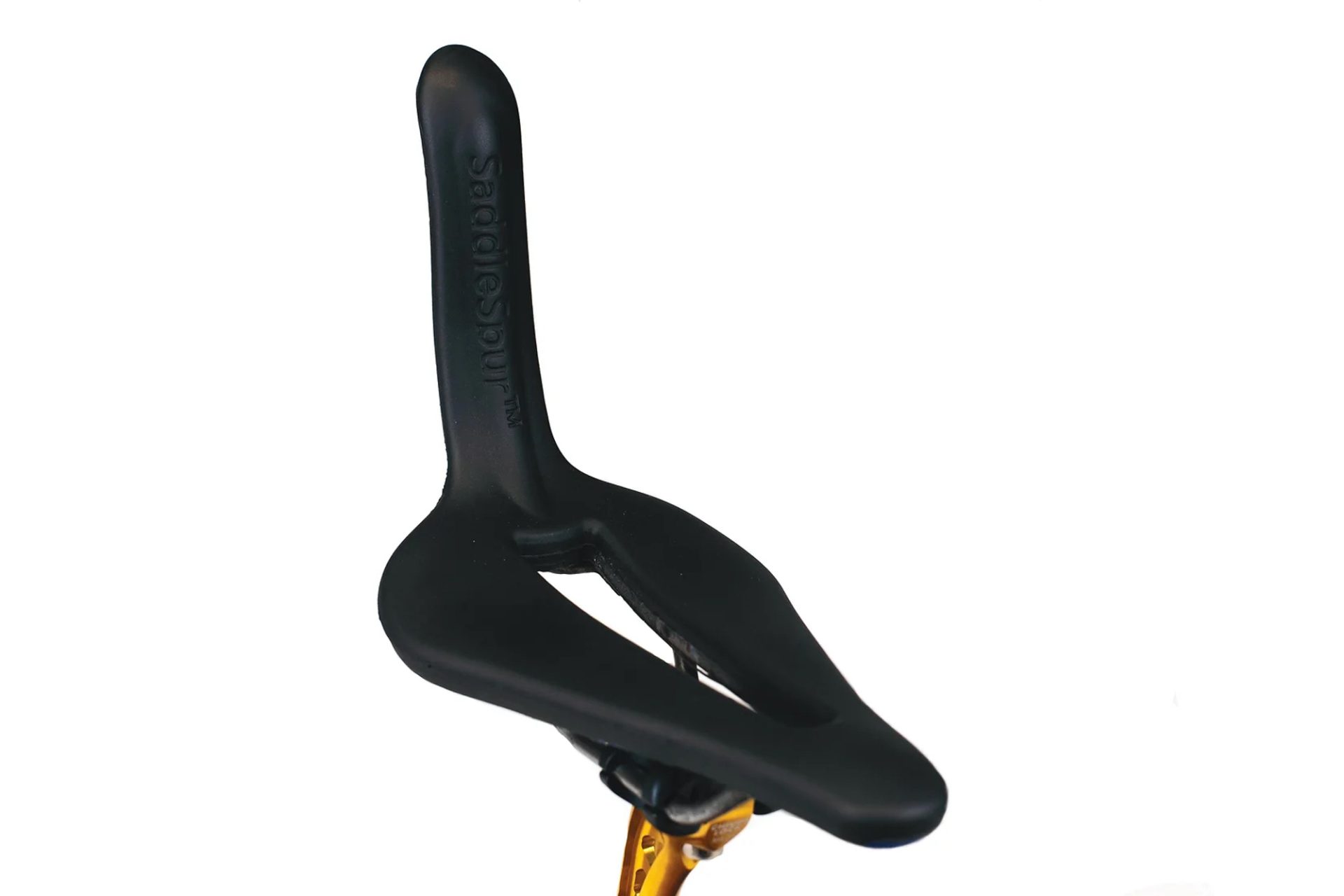Presumably, John Downing has a few inspirations for his new saddle. Perhaps he had a Schwinn Stingray as a kid, or watched the opening prologue of the 1986 Tour de France. Maybe he’s recently been to the sort of highway truck stop where it’s best not to take children.
Floating around the internet this week is news of the latest iteration of Downing’s product, called SaddleSpur. It looks, I think you’ll agree, like somebody stuck a sex toy on the back of a Specialized Power. SaddleSpur has been around at least since 2021, but the fresh mention is that the company touts a small study, set to be published in the Journal of Sporting Medicine sometime this month, that claims it saves 11 seconds in a 10-mile time trial in a lab setting. SaddleSpur claims both increased comfort and increased speed thanks to the support provided by its *ahem* spur.
We have some questions about that claim, starting with the fact that there does not appear to be a “Journal of Sporting Medicine.” (After this story was published, a spokesperson for SaddleSpur’s research partner, Anglia Ruskin University, clarified in an e-mail that the abstract will be published on a to-be-determined date in The Journal of Sports Sciences.) Downing and SaddleSpur are not the first with this idea, though. So to make it clear that writing this story is (clearly!) not simply an excuse to run that ridiculous feature photo, let’s take a trip down memory lane.
The mid-80s were a high point of innovation. Greg LeMond and Francesco Moser, for two prominent names, were experimenting with aero helmets, aero bars, and ridiculously sized wheels, and the UCI hadn’t yet stepped in with many (or any) rules governing such devices. The limitations of materials and technology at that point largely did the job of maintaining the status quo for the UCI, but that was rapidly changing.
The 1986 Tour was one of the early peaks. It was a race that would become one of the greatest Tours ever, a battle between Bernard Hinault and LeMond that would end up going to the American by just over three minutes. The story of that Tour was artfully told by Richard Moore in his book Slaying the Badger. You should pick it up if you haven’t already.
LeMond gets quite a bit of credit for pushing the sport toward aerodynamic innovation, but he wasn’t alone. Enter Thierry Marie.
Before the ’86 duel even began, French time-trial specialist Marie won the opening prologue by four seconds over LeMond, using a saddle with an L-shaped back end and large plastic fairing. It was intended both as support – as Marie’s butt sat right up against the plastic – and as an aerodynamic aid. It was branded Gitane but was just a Selle San Marco Turbo with a bunch of plastic stuck on the back. He had bullhorn bars, but no aero bars, and an aero helmet, just as LeMond used that year.
Marie came back and won more Tour prologues with similar setups. In 1991, now racing for Castorama, he beat Erik Breukink and LeMond to the yellow jersey by two and three seconds, respectively, aboard a wild-looking bike with one-piece aero bars, a more compact version of the lumbar-support saddle, now made by Selle Italia, an aero helmet, and four-spoke Corima wheels.
The saddle Marie was on was the newly launched Appoggio Lombare, literally “lumbar support” in Italian. It used a Turbo Mattic saddle and plastic fairing, providing both back support and a clean line off the back of the rider.



Marie continued to experiment through the end of his career, which finished with six Tour stage wins total, plus a couple stages of Paris-Nice and one at the Giro d’Italia. Most of his wins came in prologues. He may not have been as high-profile as LeMond, but he certainly deserves more credit for his experimentation in that era.
There were less-dramatic versions floating around as well, like the Selle San Marco Supercorsa Sprint, which flared up at the back but didn’t include any actual fairing, thus making it more similar in concept to the SaddleSpur.
Why do any of these exist? Part of the early versions was an attempt at aerodynamic improvement. Putting stuff behind your butt can make you faster, as anybody who’s part of the UK time trial scene will tell you. The proliferation of behind-the-seat water bottles and other fairings in that space is proof of that.
Beyond aerodynamics, the idea behind all of these odd saddles was roughly the same as the benefits touted by the SaddleSpur. The same benefits are touted, in fact, as those a coach will often point to when prescribing core work. When you push down on the pedals, you push against your own weight as well as your core muscles. Providing a part of the saddle to physically push against allows you to push harder, the argument goes. It’s easier to use a larger weight doing leg presses, with your back against a bench, then squats; the logic is roughly the same.
The UCI ended up putting an end to saddles like the Appoggia Lombare. They fall afoul of rules around fairings, most obviously, as well as a rule capping the maximum length of a saddle at 300 mm. The SaddleSpur isn’t a fairing, and may or may not be 300 mm long (depending on whether the Spur counts), but does look like a dildo in a location where that’s particularly funny, so the design’s success or failure may simply take care of itself.
What did you think of this story?

